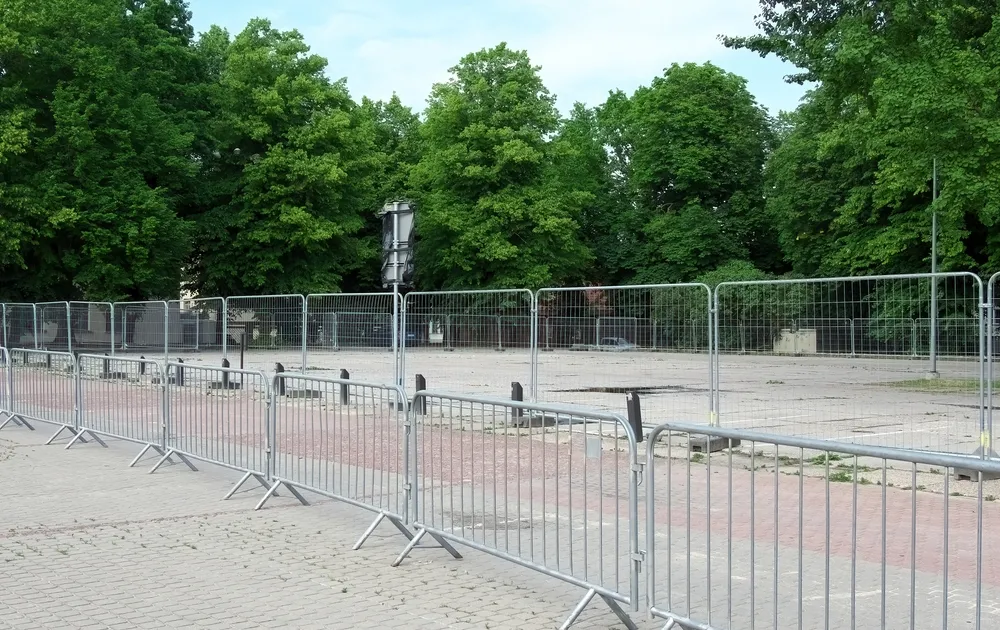When it comes to quick and reliable solutions for site security, temporary fencing offers unmatched flexibility. It can be set up fast and cheap, providing immediate security.
Whether you need to secure a construction site or manage crowds at an event, temporary fencing is an ideal solution. It ensures safety and control in any environment.
 Shutterstock: Igor Shoshin
Shutterstock: Igor ShoshinWhy Choose Temporary Fencing?
Temporary fencing provides an adaptable solution that fits various needs. It is easy to install and move, making it perfect for short-term projects like construction or events.1 Unlike permanent fencing, temporary fencing can be quickly set up and taken down, which minimizes labor costs and time commitments. It can be rented, which reduces the need for significant upfront investment. Additionally, temporary fencing helps maintain a clean, organized appearance while fulfilling safety regulations, making it a go-to choice for both small and large-scale operations.
Temporary Fencing for Construction Sites
Construction sites often require quick and durable barriers to protect both workers and the public. Temporary fencing provides the necessary security to keep unauthorized individuals out while safeguarding equipment and materials. This type of fencing is easy to install and can be customized with gates for controlled access. Additionally, temporary fencing helps ensure compliance with safety regulations, making it an essential component of any construction project.
Crowd Control for Events
Temporary fencing plays a vital role in managing crowds during events like festivals, concerts, and sporting events. It helps create designated areas, guide traffic flow, and maintain order, ensuring that everyone stays safe. Event organizers benefit from the flexibility of temporary fencing, as it can be adjusted based on the size and layout of the venue. The ability to quickly set up and remove fencing makes it the go-to choice for both small gatherings and large-scale events.
Types of Temporary Fencing Available
There are various types of temporary fencing to suit different needs.2 Standard chain-link panels are commonly used on construction sites, providing a secure barrier to keep people out of restricted areas. Mesh panels, made of woven steel or plastic, are another option, often used at events to control crowds while still allowing visibility. For added privacy, some temporary fencing solutions include screens or wraps. There are also specialized options, such as fencing with anti-climb features, that enhance security even further. With so many choices, you can find a temporary fencing solution that meets both functional and aesthetic needs.
Key Benefits of Temporary Fencing
One of the key benefits of temporary fencing is its versatility. Temporary fencing can be used for construction projects, public events, and even emergency situations. Its ease of installation means you can adapt to changing needs without hassle. Furthermore, temporary fencing enhances security by deterring unauthorized access, protecting valuable equipment, and ensuring that only authorized personnel are allowed on-site. Temporary fencing can also be modified to fit specific situations, such as adding gates or access points where necessary. This flexibility makes temporary fencing a practical choice for many scenarios.
Installation Process of Temporary Fencing
Installing temporary fencing is straightforward but requires some planning. First, you need to assess the area that requires fencing, considering factors such as the terrain, size, and shape of the site. After choosing the appropriate fencing type, installation typically begins with placing weighted or anchored base supports, ensuring the panels are stable and secure. Once the supports are in place, the panels are inserted into the supports and linked together using specialized clamps. The process is fast, often taking only a few hours for most sites, making it an efficient option for immediate fencing needs. The removal process is equally simple, allowing for quick takedowns when the fencing is no longer required.
Ensuring Compliance With Local Regulations
Temporary fencing installation must adhere to local regulations, which vary depending on the location and intended use. Compliance is crucial, as failure to follow legal requirements can result in fines or delays in your project. In many areas, height restrictions and specific safety features, such as the need for reflective markers or anti-climb designs, must be followed. It’s also important to consider the placement of fencing to avoid blocking pathways, emergency exits, or public access points. Consulting with a professional installer ensures that your temporary fencing meets all local safety and legal standards, giving you peace of mind.
Cost Considerations for Temporary Fencing
Temporary fencing is a cost-effective solution compared to permanent fencing. When calculating the costs, factors such as the size of the site, type of fencing, and length of time the fencing is required should be taken into account. Renting temporary fencing is typically much cheaper than purchasing, particularly for short-term needs. You also need to factor in the installation and removal fees, although many providers offer package deals that include these services. Additionally, renting temporary fencing reduces maintenance concerns, as any necessary repairs are often covered by the rental agreement. This makes it a budget-friendly option for most projects.
Learn More Today
Temporary fencing installation offers a flexible, affordable, and efficient solution for various site needs, from construction to events. Its ease of installation and adaptability make it a popular choice for ensuring safety and security in dynamic environments. With a range of fencing types and the ability to customize setups, temporary fencing is both practical and effective, providing a secure barrier without the commitment of permanent fencing.